Wavre a Scourge of Waterloo DLC by Slitherine / Matrix and NorbSoftDev This battle fought on the same day as Wa...

For your Wargamer, Toy soldier collector, MiniFig collector, military history nut. Reviews, interviews, Model Making, AARs and books!
slitherine
Wavre a Scourge of Waterloo DLC Review
Campaign Series Middle East 1945-1985 by Matrix/Slitherine This time around we have another Matrix / Slitherine game ...

For your Wargamer, Toy soldier collector, MiniFig collector, military history nut. Reviews, interviews, Model Making, AARs and books!
slitherine
Campaign Series Middle East 1945-1985 review
General Features:
- Numerous different platoon types; infantry, machine guns, mortars, artillery, trucks, halftracks, APC's, tanks, helicopters, landing craft, etc.
- 3D art, 2D art and 2D NATO icons for all platoons.
- Sound files for movement and weapons.
- Armour facing of armoured vehicles.
- Classification of hard and soft targets.
- Classification of infantry combat capabilities.
- Night vision for certain tank types.
- Hidden Fire for certain unit types.
- Clear and lay minefields.
- Build Improved positions and trenches.
- Lay light and medium bridges.
- Day and Night transitions during the course of a scenario.
- Ability to set Opportunity Fire against Hard, Soft, Other and Anti-aircraft platoons.
- On-map thermometers for Action Points, Morale and Strength for all platoons in all map views.
- Three Fog of War levels.
- Desert and Mediterranean terrain classifications within the map editors.
- Civilians.
- Comprehensive manual.
- Numerous display options allowing the customer to set up the game to their requirements/preferences
Suez Crisis of 1956
Six Day War of 1967
War of Attrition
October War of 1973
Invasion of Lebanon in 1982
Algerian War of Independence
Egypt in Yemen
United Kingdom in Aden
Libyan - Egyptian Border War 1977
This was a review of the 1.02 version, the following is a rundown of the update:
FIXES
• Revised Linked Campaign Game Strength Point carry-over issue
• Revisions to the Unit Viewer (F3)
• Fixed several issues involving airstrikes
• Fixed another off board artillery bug
• Fixed occasional edmap launch crash bug
• Adjusted vertical positioning of 2D bridges and ford for engine, edit and edmap
ENHANCEMENTS
• Implemented Options Mouse Wheel Zoom
• Implemented Options Hex Contour Widths 1/2/3
• Implemented Options Cursor Small/Standard/Large for varying cursor sizes
• Implemented Options Cursor Enhanced for a frosted cursor
• Implemented Options Details Persistent, a toggle that indicates whether the Damage Report persists until click (or the Esc key is pressed), or vanishes after a delay automatically
• Added terrain feature: Ditches (hexside anti-tank ditches)
• Added terrain feature: Crests (hexside)
• Added terrain feature: Water Block (hexside)
• Added terrain feature: Industrial (hex, for desert terrain)
• Substituted a new engine toolbar, with new OP FIRE button, revised Climb/Descend buttons
• Revised Top of Stack/Bottom of Stack buttons
• Substituted BoxArt style command and results dialogs
• Substituted square nation flags for roundels in the Organization Editor
• Improved diagnostic logging
• For terrain and counter draws, set compiler option to optimize for speed
• Implemented ON_CYCLE as hot key (TAB) for faying hex’s terrain about available alternatives
• Elevation Delta now saved between sessions for engine, edit and edmap)
• All airborne helicopters flying in the Low or High flight zones now have a spotting capability, even if unarmed reconnaissance or transport
GRAPHICS
• Revised a few 3D terrain and vegetation tiles
• Revised 2D terrain and vegetation tiles
• Revised Iraqi 3D graphics
• Revised United Kingdom 3D graphics
• Special graphics and units that are amphibious have been given appropriate graphics
• Revised all 3D graphics with a muted look, allowing 3D units to stand out clearly against the terrain
DATA
• Updated Weapon.pdt file, revising existing information and adding new information for new units
• Updated 09,14,22,23,24,30 platoon.oob files with additions and corrections
SCENARIOS
o New Scenarios by Jason Petho:
o No Match for the 100 (Bir Gifgafa 1967)
o Tourney - Set A01 - High Noon
o Tourney - Set C01 - Hack and Slash
o Tourney - Set C02 - The Villages
o Tourney - Set D01 - Dancing in the Desert
o New Scenario by Jim Mays:
o Tourney - Set B02 - A Furious Charge
o New Scenarios by Alan R. Arvold (available in the mods folder):
o Arab-Israeli Wars Scenario #1
o Arab-Israeli Wars Scenario #2
o Arab-Israeli Wars Scenario #3
o Arab-Israeli Wars Scenario #4
o Arab-Israeli Wars Scenario #5
o Arab-Israeli Wars Scenario #6
o Arab-Israeli Wars Scenario #7
o Arab-Israeli Wars Scenario #8
o Arab-Israeli Wars Scenario #9
o Arab-Israeli Wars Scenario #10
o Arab-Israeli Wars Scenario #11
o Arab-Israeli Wars Scenario #12
o Arab-Israeli Wars Scenario #13
o Arab-Israeli Wars Scenario #14
o Arab-Israeli Wars Scenario #15
o Arab-Israeli Wars Scenario #16
o Arab-Israeli Wars Scenario #17
o Arab-Israeli Wars Scenario #18
o Arab-Israeli Wars Scenario #19
o Arab-Israeli Wars Scenario #20
o Arab-Israeli Wars Scenario #21
o Arab-Israeli Wars Scenario #22
o Arab-Israeli Wars Scenario #23
o Arab-Israeli Wars Scenario #24
o Arab-Israeli Wars Scenario #25
o Arab-Israeli Wars Scenario #26
o Arab-Israeli Wars Scenario #27
o Arab-Israeli Wars Scenario #28
o Arab-Israeli Wars Scenario #29
o Arab-Israeli Wars Scenario #30
o Arab-Israeli Wars Scenario #31
o Arab-Israeli Wars Scenario #32
o Arab-Israeli Wars Scenario #33
o Arab-Israeli Wars Scenario #34
o Arab-Israeli Wars Scenario #35
o Arab-Israeli Wars Scenario #36
o Arab-Israeli Wars Scenario #37
o Arab-Israeli Wars Scenario #38
o Arab-Israeli Wars Scenario #39
o Arab-Israeli Wars Scenario #40
o Revised Suez Linked Campaign
o Revised all affected scenario/campaign maps with new Industrial terrain hex
o Scenario Modifications to:
o The Crossroads
o Off to Giddi
o Bootcamp 3
o Battlefields of Old
o Raid Into Libya
o Into the Ring
o A Taste of Sa’iqa
o Into Africa!
o The End in the Sahara
o Hot Knife Through Butter
MODS
We have included a number of user made modifications that may enhance your gaming experience. It is recommended to use the JSGME Modification Enabler Software that is included as part of the installation. See Section 16.3 for instructions.
• Alan R. Arvold Ode To Arab-Israeli Wars – This is a scenario set based on the Arab-Israeli Wars created by Alan R. Arvold.
• Ode to Arab-Israeli Wars – This is a 2D graphics modification by Petri Nieminen (aka Crossroads) to provide the players of the Ode to Arab-Israeli Wars scenarios an authentic look and feel when playing the scenarios.
• Alternate 3D Bases – This is a 3D graphics modification that simplifies the roundels in the 3D view, making them easier to distinguish against the terrain.
• Black 2D Unit Profiles – This is a 2D graphics modification that converts the coloured unit graphics to black silhouettes.
• Black Unit Info Box – This is a UI graphics modification that removes the background information when using the Unit List, making the unit information easier to read.
• MausMan 3D Graphics – This is a massive 3D graphics modification that converts all 3D terrain graphics to a smaller scale.
• NATO Icons w. Transp. Background – This is a 2D graphics modification for NATO symbols that removes all colour coding and just displays the black outlines.
• NATO Icons w. White Background – This is a 2D graphics modification for NATO symbols that replaces all colour coding with a white background.
MANUAL
The manual has been revised to 1.02 UPDATE standards. It has also been combed through; revising graphics and grammatical errors, in addition to incorporating comments from users (inclusion of 2D and 3D screenshots, for example).
Strategic Command WWII -- War in Europe Board Game Precursors Let's face it, certainly one of wargamers' most beloved si...

For your Wargamer, Toy soldier collector, MiniFig collector, military history nut. Reviews, interviews, Model Making, AARs and books!
slitherine
Strategic Command WW2 - War in Europe PC Game Review
Let's face it, certainly one of wargamers' most beloved simulations has been strategic command in World War Two, especially in the European theater. Some must admit cutting their teeth on Avalon Hill's 1974 Rise and Decline of the Third Reich or possibly its 1992 successor, Advanced Third Reich. In fairness, let's not forget Australian Design Group's 1985-2007 World in Flames series and also Decisions Games card-driven Krieg! World War II in Europe and its successors in 1999 and 2011. Another recent entry that scores good marks is GMT Games' Unconditional Surrender. There are other board-games. too, but these are those the reviewer finds deserving of memorable accolade.
Fair enough, just giving a taste of where all this originally debuted. The purpose of this article is to review the most up-to-date PC title of the Strategic Command Series, the latest being released by Slitherine on November 17th, 2016.
Interestingly, this is a PC game that has a development story of its own. Just like board game players, PC players want more detail, performance and better graphics as the years go by.
These sequences are money-makers for the gaming companies and we don't begrudge this. Most recently, I had purchased the last version of this game from the previous publisher, Battlefront: Strategic Command WW2 Gold Bundle. Amazingly, just after that, Jason asked me to review games at A Wargamer's Needful Things, so before I had ever played this older version, I was in the thick of looking over Strategic Command, WW2 in Europe.
The original developer, Fury Software, has moved to work on with Slitherine/Matrix. Fury has been culturing this series since 2007 and have made a splendid choice to continue to do so with the new publisher. Fury's craftsmanship and TLC approach is enhanced in this new iteration of the game; I can attest through gameplay that you will see a devotional level of attention and detail.
Before you start your PC engines bent on terror and destruction of the AI enemy, you'll need to check out the gaming manual. The document has excellent structure and detail, so you won't get lost.
The thing is, the AI, even on the novice level, will put you through your paces and won't pull any punches. This is one game where you will want essential understanding regarding the mechanics of: HQs, supply, morale, purchases, rebuilds, reinforcements, scripted events and combat mechanisms for land/air/sea. You'll find everything you need in the manual, and it's worth paying attention.
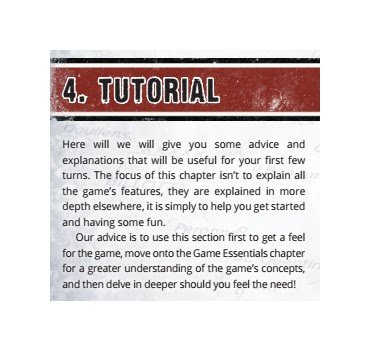 |
| Trust me, you'll 'feel the need'! |
This is a PC wargame with the complexity of Advanced Third Reich; you'll need to understand how the systems work, while the computer program takes care of the implementation. To put it another way: if you plunge into the game, as I did, with only rudimentary comprehension, the AI will spank you here, there and all over if you let it. I lost half the Kriegsmarine in the early parts of the game for lack of preparation, for example.
Where to begin? The good news is the manual is comprehensive and well-organized; the bad news, if any, is that you can't afford to skip it.
| One of the first choices you'll make |
One of your easier decisions is choosing unit icons: silhouettes or NATO? I started with the former but eventually switched to the less glitzy but more utilitarian NATO view (showing my age, no doubt).
Note: there is a lot of information you'll be shown on these icons, and the symbol meanings are not immediately obvious. You'll need to refer to the manual to know why units are flashing or not, why some have white dots on them, etc. Honestly, I never mastered all of this while playing the game but I'm convinced it was detrimental not to have done.
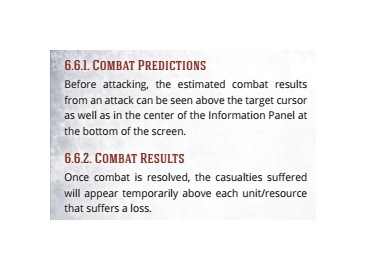 |
| these predictions are very helpful but there's more to the story... |
The reason I failed to explore the details thoroughly can be blamed on too-heavy reliance upon onscreen combat predictions to make decisions. Players familiar with Panzercorps (for a review, click here) will easily recognize this helpful, if not comprehensive, feature.
 |
| A must read; put it alongside your copy of of Baron de Jomini |
Keep in mind that combat is conducted by individual units. Therefore, to defeat an enemy unit, it's important to attack sequentially with powerful assaults. For example: medium bombers can first defeat entrenchment levels, tactical bombers (e.g. stukas) then reduce the strength of the enemy, panzer units attack twice to punch through, infantry armies attack more effectively than infantry corps, and so on. Since all hexes have a stacking limit of one for all types of units, organization on the ground is a major factor of success. For example, one infantry unit can attack, then move away and make room for the panzer unit to finish it off. I found the AI was very efficient at this ( esp. compared to me!).
 |
| Don't skimp on the research funds or you'll find panzer IIs fighting Stalin tanks! |
Success is also dependent upon the research and level upgrades the player decides to purchase for unit types. There are a lot of decisions to make with difficult-to-foresee long-term impact on the game. When you do see it, it could be too late!
 |
| There are plenty of detailed reference tables |
 |
| Be mindful of your political aspirations then pony up! |
 |
| Did you forget to read this? |
Yes, I did read the strategy guide and it's very useful to keep in mind, but the part I didn't read up on sufficiently was this:
 |
| These decisions are made throughout the game and significantly impact strategic direction |
In the case of my game, I thought I had to figure out how to invade Norway with the Kriegsmarine; as a result, I lost a few ships before a decision announcement was made by the game that I could pre-pay for an invasion of Norway.
Oh, really??
At first, I thought this was kind of hokey, because inevitably in most strategic games, the simulation of the Norway invasion is not a bright bulb in the design. 'Here we go again' crossed my mind.
Later, I was sending stuff over for the invasion of Egypt when I received another strategic decision point, and was asked if I wanted to invest in the Africa Corps or not. I said 'dummkopf what does it look like I am doing' as I had send a panzer division, additional corps and other air units already!
As it turns out, these are the game's mechanisms to simulate funding for alternative operations that you may not want to spend money on.
Because I had loaded up on units in Africa, I swept the British from all of the middle east and with Spanish help, I took Gibraltar. On the negative side, Barbarossa wasn't so hot, due to my heavy investments in the U boat war, naval capabilities and efforts versus the Western Allies. The strategic choices are the player's to make, but don't think the AI won't do something to counter your decisions. Meanwhile, it's making decisions on special scripts as well!
 |
| It's a double feature! |
Readers, I started the analysis from late 1940 because there is plenty of coverage out there on how to handle the Axis for the Polish and French campaigns. One thing to keep in mind, though, is that transferring units across the front takes a lot longer than you might anticipate. Strategic operation is quite expensive and digs into the pocketbook every time it's used. So make sure to start marching those units in Poland back to France at the earliest opportunity because you'll feel yourself unprepared to launch an incisive attack on France. It took me too long to conquer both countries.
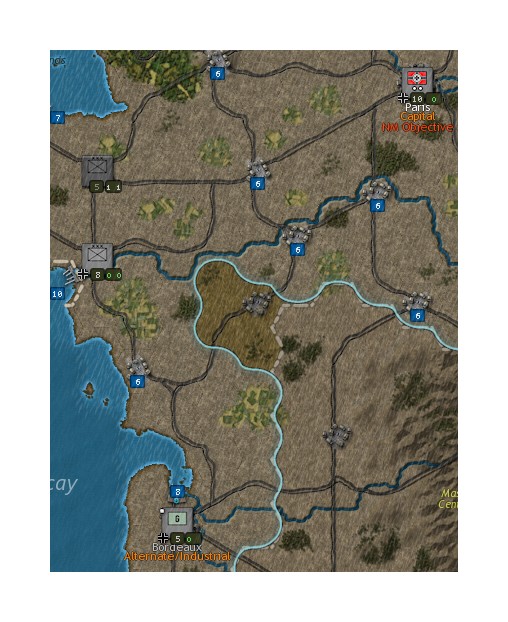 |
| Occupied France |
Early on, get used to making sure the partisan centers are occupied: compare above image with that below:
 |
| Partisan centers in France. Why these spots need to be occupied. |
The U boat war is important for Germany. The player needs to get the subs out there using 'silent mode;' then, once on top of the (red) convoy lanes, put them in 'hunt' mode to sink the merchant ships. This is represented abstractly (as in most strategic WWII games) as loss of money (or MPPs).
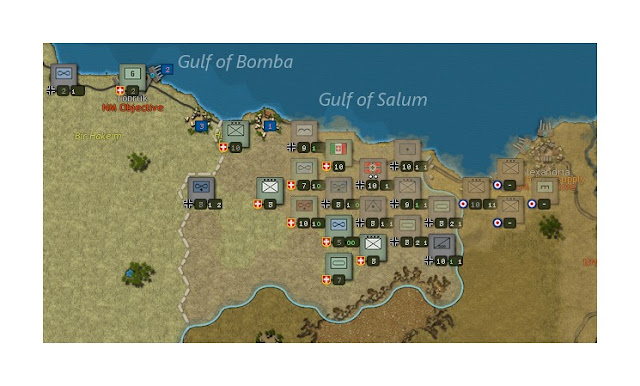 |
| North Africa. The Axis will go on to overwhelm Britain here, in spite of Colonial reinforcements |
A lot of Axis units were placed in North Africa due to a scripted decision that brings in Rommel and buddies. As previously mentioned, I had already sent a bevy of reinforcements as soon as Italy entered in mid-1940. All these assets proved too much for Britain and her Pacific allies -- but the AI put up a valiant fight.
 |
| Diplomacy: Germany invests heavily in Spain and Turkey; ultimately they both enter the fray! |
Malta had been a problem interdicting supplies to North Africa, consequently slowing down my attacks. In turn, an effort was made to bring Spain in, so as to cut off supplies to Malta. Eventually, the Germans got close enough to Alexandria to have air units hunt down the British Fleet, and after a series of heavy battles with naval air units and the Italian navy, The British force was KO'd, including a valuable carrier. The Commonwealth forces put up a stiff fight and a lot of money points were spent repairing naval forces and sending reinforcements to the Africa Corps ground units. Consequently, none of that money made it to the Russian front.
One note -- it's a bit too easy to repair fleet units. Even if down to one point, it takes just one turn (usually two weeks) to sail them to a port, one more turn to repair them to full capacity (depending on how close the port is to a full supply source or home waters) and then they are back in action at a full 10 strength points. Of all the systems in the game, the naval system seems to be the most arbitrary -- not that it isn't fun! That's the balance to be found -- boring naval battles or fun ones. A difficult design decision and I am not unhappy with how Fury has gone about doing this.
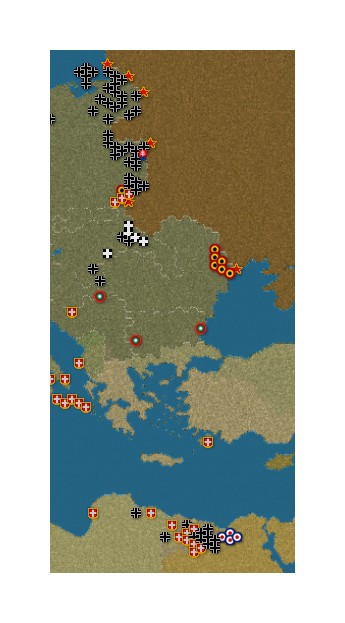 |
| This strategic view shows the forces for Barbarossa and the mass of units serving Rommel! |
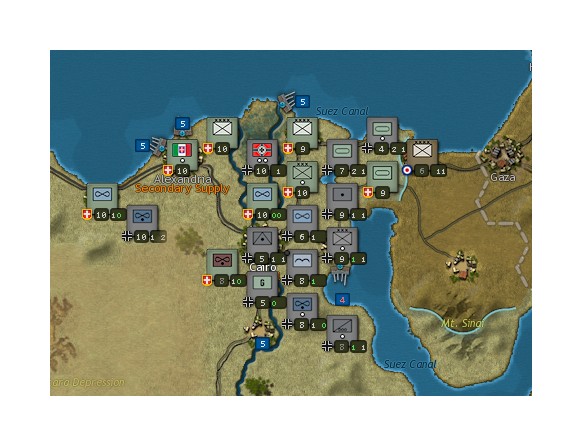 |
| Disaster in Egypt -- Demoralization for the UK |
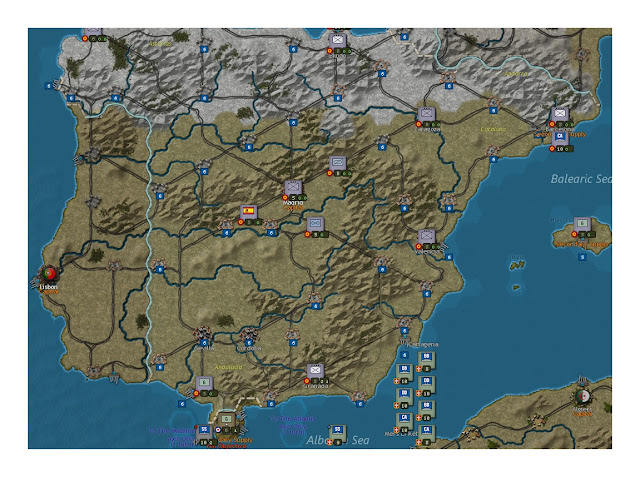 |
| Iberia with neutral Portugal and Axis Spain. Gibraltar will be taken and the Italian fleet unleashed! |
 |
| Close approach to Moscow but that is as close as I'll get! |
| Due to lack of an HQ in the area (uselessly sent to Finland) I could not and never did capture Riga. It also took a long time to reduce Pripyat marshes, again, due to insufficient HQ support. The Germans needed at least two more HQs and probably about 10 more armies in Russia. But I had spent the money on U boats and North Africa. There are trade-offs, and the AI knows about them!
September 1942 -- USA in the War
|
 | |
| U Boats and Raiders terrorize the Atlantic |
1942 started out grimly for the Western Allies. Readers can see the extent of U-Boat operations, including an Italian Caribbean raider in the lower left corner.
 |
| Italian and German surface fleets poised to intercept potential Allied operations in the area |
Massive funds had been spent in the West and naval superiority (or at least parity) was achieved for the moment. But as a consequence, the war in the East is a bit frightening for the Axis because not enough effort has been devoted to handling that front properly.
 |
| September 1942: Disorganized Germans pushed well back from Moscow and beyond Smolensk. |
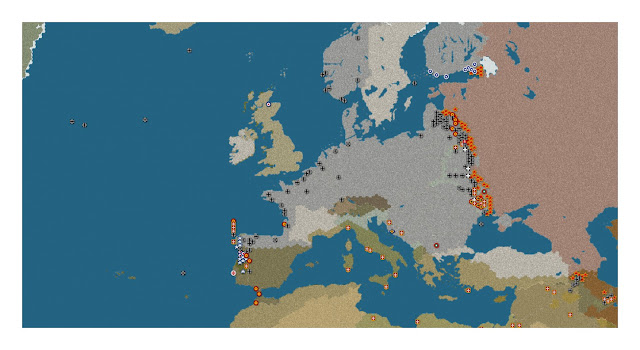 |
| Stabilizing the Russian lines and fending off the invasion of Portugal! |
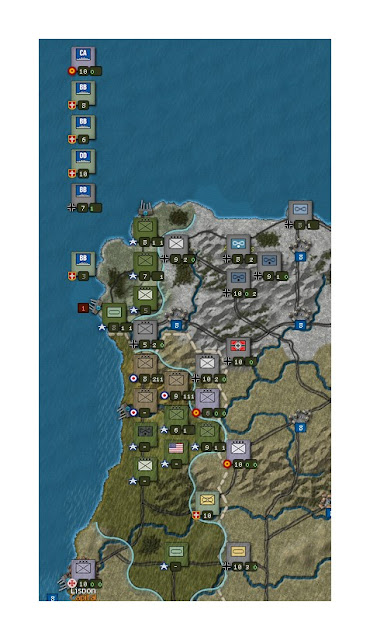 |
| Detail of bitter fighting in Iberia; Axis fleets searching for and finding Allied troop convoys: The Bay of Biscay is now known as Ironbottom Bay |
 |
| A good turn for Germany and friends! |
1943 is a stabilizing year for the Germans as I finally get my act together on managing the Russian hoard, which is not to say they are fully leashed by any means. And in the West, some nice counterattacks sink the Hood and destroy some valuable American land forces. Note that this Combat Summary is received every turn something is destroyed -- of course, sometimes the news can be pretty bad!
 |
| More Axis units fighting to control the channel. By now the WA have lost 5-6 carriers due to aggressive operations |
In general, the AI does a fair job handling the naval units, but losses are a bit more random and dramatic than what is usually seen on land. Once the carriers expose themselves and fail to hide after some rounds of attacks, they are exposed to counterattacks by surface vessels or U boats in range. I'd say the AI suffered more than it gave in these battles. But it is fair to keep in mind that the Germans invested heavily in U boat numbers and repairs. Most definitely the Axis were fighting a western front strategy in this game.
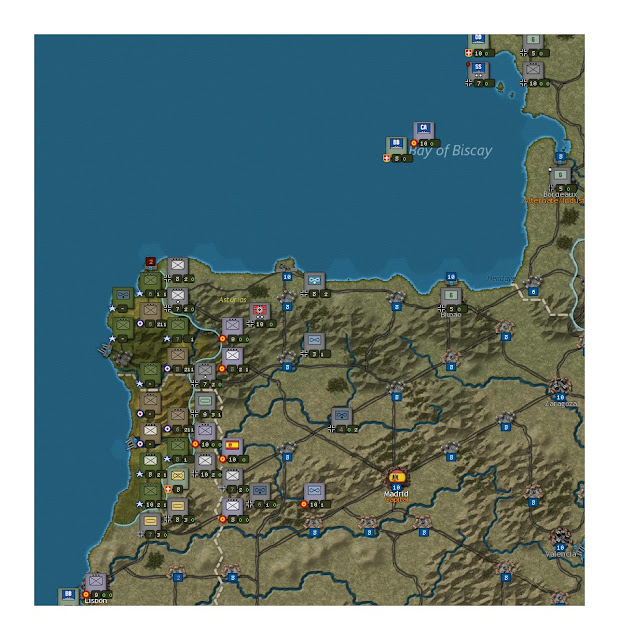 |
| WA invasion is in trouble. Many Western Capital ships have been lost. The WA can't get supplies or air units through, |
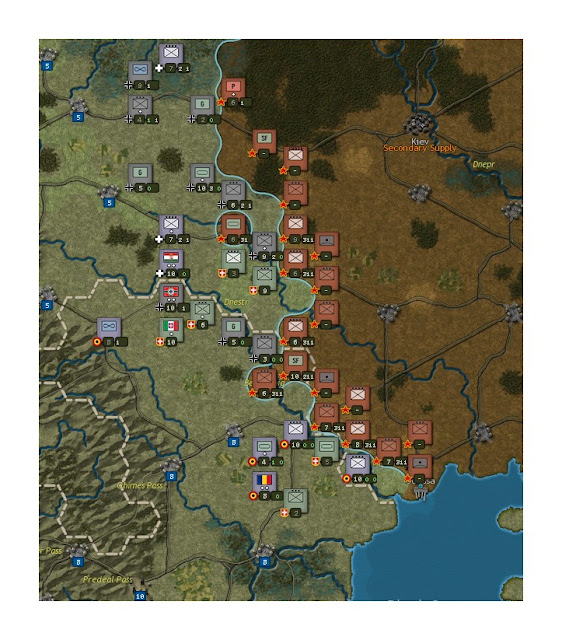 |
| Strong USSR forces can pound the minors. Romania is getting nervous! |
Readers, due to time constraints and commitments, I needed to finish this review before completing the entire war, but I do feel as if I can make some valid observations about this fine computer simulation.
First and foremost, the game and scripting (that is, decision events) build a sense of tension for the upcoming campaigns. Additionally, these provide some structure for novice players, such as myself. Note that I did play this on the novice level and felt sufficiently challenged by the AI.
One could make the point that scripted events are also a kind of way for the designers to 'get away with' not simulating difficult aspects of the game. But this is not unusual in board games that cover the strategy of WWII. Norway is notoriously difficult to simulate. The designers decided to cover the invasion with an abstract decision to do so or not. If the German player decides to do it, the invasions of Norway and Denmark are automatically successful (don't waste time and resources doing a land campaign in Denmark like I did!). The same is true for a scripted decision -- or not -- to send Rommel to North Africa. While I haven't played the Allied side yet, I'm sure the same scripting is conducted in various situations on their end. One I witnessed, that was not historical, was the British occupation of Irish ports to facilitate Atlantic operations.
Finally, I must point out that one seriously enjoyable element of the game is how seamlessly intertwined game actions can be conducted. One can start moving around some subs, then move on to the east front, then make purchases or reinforcements, stop doing that and conduct diplomacy then come back to land attacks. Nothing is phased in any sort of rigid sequence of events. That's all handled by the program after the player pushes the 'end turn' key.
Obviously crucial to any simulation of WWII in Europe is how land maneuvers and combat are handled. The game avoids the mechanic of gathering forces for odds-based attacks, instead simulating combat as sequential attacks by individual units. I haven't made up my mind if I like this or not. It can be difficult to manage and predict how units are to be organized on the ground for an upcoming series of battle attacks to destroy enemy units for breakthroughs. My conclusion is that my inexperience is a factor. But not even the AI did much in the way of breakthroughs. Combat seemed to be more 'attritive' and 'WWI-ish' than what reminded me of the bulk of WWII maneuvering combat. Certainly, there were cases of attrition and stalemate in WWII, but I'd like to see that as more of an exception in this game. Perhaps with more experience playing, I would indeed be able to see more battles of encirclement than sequences of head-on attacks.
The air war is simulated pretty well, but again, highly based on attrition and reinforcement. The sequence of how air attacks are handled is at first abstract and then later simply becomes a bit repetitive in how it is represented in a series of pop-up windows. More exciting would be a series of animation screens.
The naval war simulation is likely to generate the most controversy. Naval units, like any other units, cannot stack. Therefore, it is impossible to represent the fleet as based in a single port, such as Scapa Flow or Taranto. One ship can be in a port, the others are going to be floating around at sea unless they find another haven. However, the fog of war makes up for this, as ships cannot be seen unless scouted by the enemy with air or other fleet units. And it can be a bad idea to get surprised at sea by running into a vessel, ambush is very possible. Personally, while I had my doubts about the naval system, in the end I rather enjoyed it. Moving a naval unit is fraught with tension! Will I discover an enemy carrier I can send my battleships after? Or will my sub run into a barrage of depth charges by finding a DD unit guarding the sea lanes?
Overall, I'm very happy with the combat systems in the first playing of this game; I'm sure, as a newbie, I missed some very important nuances about all three forms of combat interactions.
These elements seemed to work well. Players should keep in mind that production is not immediate, nor are diplomatic results. The same is true for researching new capabilities. It's important to remember that for some research, the breakthroughs still require upgrading the units in the field to the better weapons! I definitely struggled with this trying to push to the East. You can't fight if you are upgrading and reinforcing.
My only bone to pick with the game is that it's much too easy -- or seems so -- to reinforce naval units that have been severely damaged. They are back up and running withing a couple of turns, and this is simply not how quickly naval units can be refitted. I do think this is something for the developers to look at in the next go-round.
Of all the elements, I found this the most murky. Perhaps I needed to read the manual on this in more depth. But why does Poland's morale stay on the display after it is conquered? Or France's? One thing the software does mostly well is get rid of or hide unnecessary data, but not so this. Also, when your national morale level is, for example, 99,248, then a player gets an additional 300 +/- morale for sinking the Hood, well, so what? It's shruggable. Why 300? Why not 1000? Plus the game doesn't tell you how much morale the British have lost by losing the Hood. This is one simulation area that could use a bit of fleshing out to become more meaningful for the player.
By all means! Especially if you enjoy strategic simulations of WWII, you won't be disappointed and the game feels as if it is highly re-playable. Take note that there is a more than moderately steep learning curve for this PC game. The manual is digestible, but not in one reading. This is a game that will take time to master, especially until multi-player is available (enabling teaching situations). Right now the quickest way to learn the game is to play it, in spite of the helpful videos out there. There is that much to take in, so if you are looking for beer and pretzels, this might be a bit much. Otherwise, enjoy the banquet!
Sanctus Reach Trailer! Click to go to Steam page
Flashpoint Campaigns: Red Storm Players Edition & Reforged DLC Review I purchased Flashpoint Campaigns: Red Storm not...

For your Wargamer, Toy soldier collector, MiniFig collector, military history nut. Reviews, interviews, Model Making, AARs and books!
slitherine
Flashpoint Campaigns and Reforged DLC Review
Flashpoint Campaigns: Red Storm Players Edition & Reforged DLC Review
However, wargames on a computer opened up whole new possibilities when it came down to wargame mechanics. So, we saw wargames played out in 'realtime' where the clock kept going and players (or yourself and the AI) simultaneously made their move; games like Close Combat followed this path. Also you still had wargames using the old IGO/UGO mechanic right up to this day. In fact, it's still the most used mechanic. Then, along came Combat Mission with its WEGO mechanic. Here you and your opponent, be it another player or the AI, plot your moves and once happy and you've both clicked for the next turn the game would then, like a movie clip, play out in front of you for 1 minute as you watch, biting your finger nails, your pixeltruppen follow your plotted moves.
I fell in love with this mechanic there and then. I loved the tension it creates, plus in Combat Mission you could replay the turn as often as you like from all angles, so you'd never miss out on any action, unlike realtime games where you could miss out on all sorts as you're dealing with something across the map. So from then on, any game using the WEGO mechanic instantly gets my attention. IGO/UGO at lower scales feels a bit forced, REALTIME too fast and can end up a clickfest, where as WEGO fits the bill perfectly. This is why I purchased Flashpoint Campaigns: Red Storm. A purchase I certainly don't regret.
Flashpoint Campaigns: Red Storm is set during the Nineteen Eighties and the Cold War has gone HOT! The game is kind of a sequel, but more a major upgrade of a previous game called Flashpoint Germany, a wargame published by Matrix back in 2005 (whose scenarios became Red Storms DLC. See later in the review). The game features 20+ scenarios, in which you can play as either the NATO side, whose forces consist of USA, UK and West German, or play as the WARSAW pact commander Soviet forces. Plus there are four campaigns, that's right FOUR campaigns, giving you the chance to play as one of the NATO nations or as the Soviets. In the campaign you have a 'core' force which gets carried over from one mission to the next, getting repaired and replenished between each scenario. You also get 20+ maps of central Europe, mainly focused on Germany and based on real world data.
As mentioned at the beginning, the turn mechanic is WEGO with a very clever twist. The turn length all depends on your nations command, control and communication ratings which can be affected by electronic warfare and casualties. This is called your command loop and a major feature of the game is to get in your enemy's command loop, which means you can react more quickly, as you get the chance to issue more orders than the enemy.
NATO has the upper hand from the get go here. So, for instance, you as the NATO player have a 12 minute loop; this means twelve minutes of game time will move forward until you get the chance to issue orders again. Now, at the same time, the WARSAW pact player may have a 30 minute command loop and so has to wait thirty minutes. This means the NATO player has had two opportunities to move before the WARSAW pact player gets his second chance. As I'm sure you can see, over the many hours a scenario usually plays out in, this can have a massive effect on the outcome. Nail biting stuff!
The game has an extensive TOE for all sides based on their real life eighties counterparts. Add in dynamic weather, counter battery fire, air strikes, helicopters, mines, fortifications, obstacles, recon units, active FOW and NBC unit capability. Now why have NBC capability? I'll tell you why, not only does it have chemical weapons, there are also tactical NUKES!! That's right Nukes! Sounds like overkill..well I'll tell you this, the first time I nuked I still lost!!
I found the UI to be very good indeed. The player has lots of info at his fingertips and issuing orders is straight forward. The game has lots of player options that can affect the actual game and its difficulty or let you change the colour of things, like fire lines and unit highlight box etc etc. It's all well thought out and you can see the devs have really given some thought about the UI and what different players may want and so have given you the tools to change certain things to fit your taste. In fact, going further, the game is also mod friendly and if you check the forums you'll find lots of mods and user made scenarios out there, even ones set during WW2 or the swinging sixties! At the end of a scenario you get an AAR which breaks down how each unit performed, as well as issuing out awards to those units that stood out during the battle. I love this kind of immersion\chrome.
Now I loved the game and not that long ago to coincide with the release of its DLC a huge update came out upgrading the game to 'The Players Edition'. This update improved all aspects of the game and is the version you'll purchase if you buy the game today (It's actually just had another major update which adds a host of new features for instance a new Intel Map screen). Now I do have some quibbles with the game. I've always been suspicious of how units can spot and shoot each other across city hexes, plus I find at times Infantry could be a bit more difficult to kill, though it's a lot better in this respect than many other wargames out there where infantry are just endless canon fodder. Some of the issues raised in the forums will, the developers say, be ironed out in the next game/expansion in the series, Southern Front. Southern Front will, as the title suggests, cover the fighting further south. There is also talk of a WW2 game (yes please) at some point in the future.
I truly feel Flashpoint Campaigns: Red Storm will go down in wargame history as a classic of its time. I have no hesitation recommending it to all wargamers. So go read the forums and make that purchase!
As mentioned further back Flashpoint Campaigns: Red Storm has a daddy and the daddy was called Flashpoint Germany. Red Storm is bigger and better than its father but the scenarios its daddy packed where just too good not to upgrade with all the bells and whistles Red Storm can bring to the table. So to rectify this along comes Flashpoint Campaigns: Germany Reforged
The expansion includes 17 new scenarios plus 43 different variations with the original Flashpoint Germany maps totally redone for Red Storm. Not only do you get the four maps from Flashpoint Germany, you also get a brand new, extra large, map 'Eiterberg' - it's nearly twice as big as all other maps, so the player can create some huge battles.
If you love Flashpoint Campaigns: Red Storm then buying the expansion Flashpoint Campaigns: Germany Reforged is a no brainer.



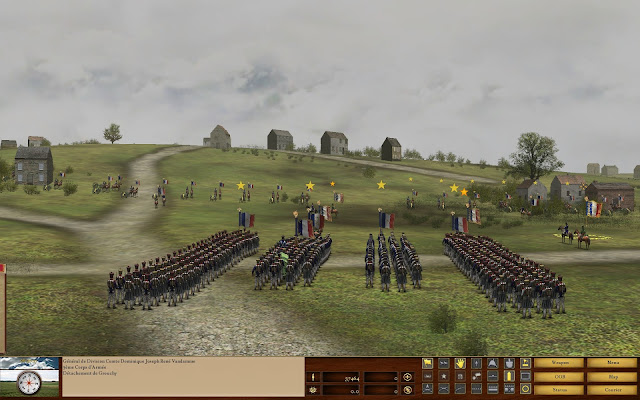









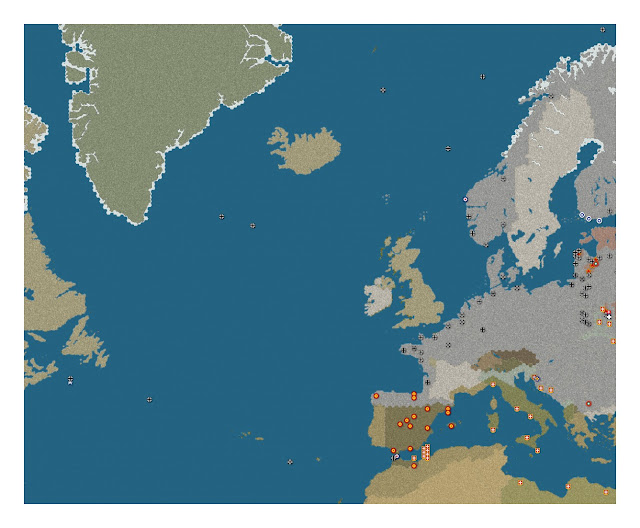
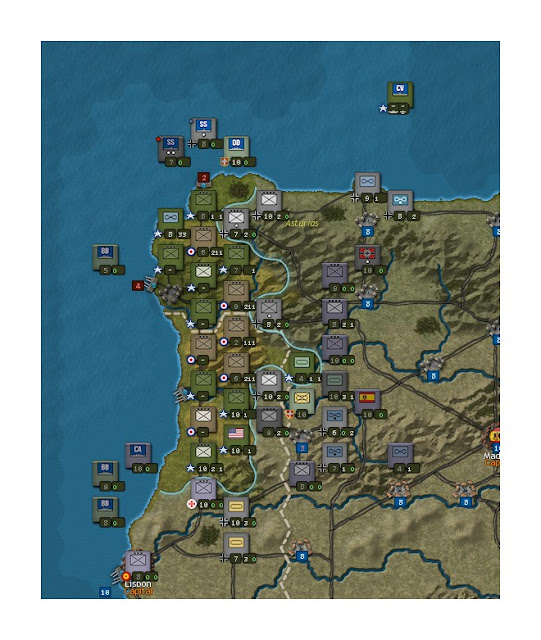




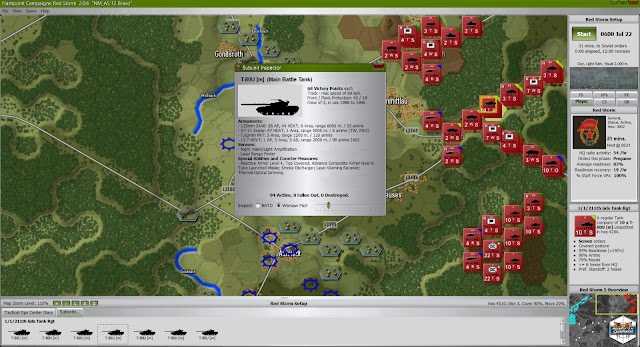









Follow Us